#mythography
Explore tagged Tumblr posts
Text
The Science of Discovering the Past: Mythography
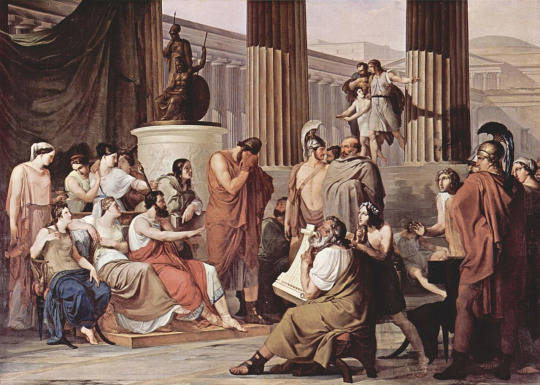
By Francesco Hayez - The Yorck Project (2002) 10.000 Meisterwerke der Malerei (DVD-ROM), distributed by DIRECTMEDIA Publishing GmbH. ISBN: 3936122202., Public Domain, https://commons.wikimedia.org/w/index.php?curid=152601
Myths are the stories that are past down in civilizations that play a fundamental role in their societies. They can be religious or secular in nature. A secular myth can be one that tells of the origin of a group of people or a nation while a religious myth could be one that tells of the origin of the world and may overlap with a national origin myth.
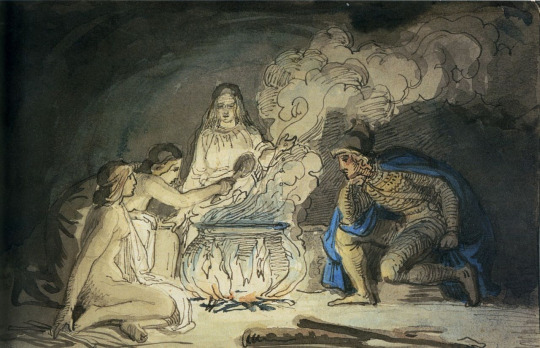
By Lorenz Frølich, Public Domain, https://commons.wikimedia.org/w/index.php?curid=32694681
Mythography and comparative mythology are ways of studying myths. Mythography is the systemic study of myths that seeks to uncover origins and hidden meanings under the surface of myths, seeking to understand where they began and how they spread through the world. It seeks to understand the reasoning underlying various motifs, or mythemems, within various myths and how they changed between cultures. It can be traced back to Palaephatus, a Greek mythographer who lived sometime during the late 4th century BCE, and his work On Incredible Things, or On Unbelievable Stories, depending on the translator. He wrote about myths and then posited on the origins of them. One example of his work is '[t]he story about Callisto that is while she was out hunting, she turned into a bear…that she too during a hunt found her way into a grove of trees where a bear happened to be and was devoured. Her hunting companions saw her going into the grove, but not coming out; they said that the girl turned into a bear'. While his theories are considered to be ad hoc, he also didn't mention the gods. In Calisto's story, it's traditionally held that Artemis turned her into a bear for her unfaithfulness as her priestess.
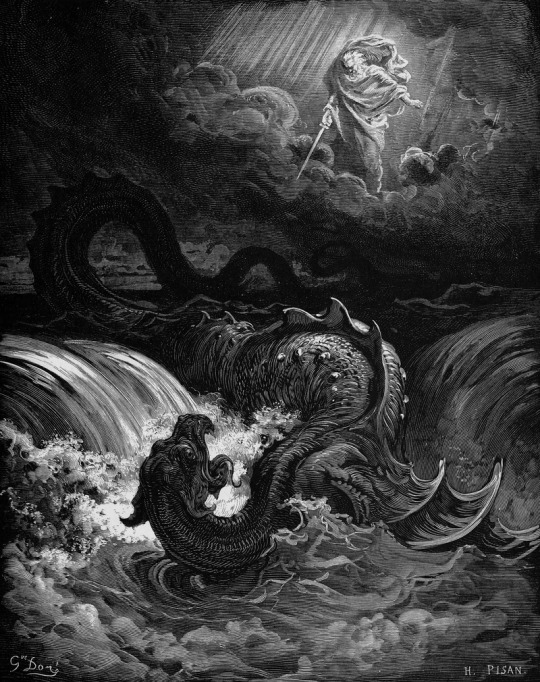
By Gustave Doré - w:en:Image:Destruction of Leviathan.png, Public Domain, https://commons.wikimedia.org/w/index.php?curid=283522
Comparative mythology is a closely related field that studies myths from various specialties. These include linguistics, religious studies, history, and literature. The linguistic branch studies how words, such as the names of the gods, are related. Claude Lévi-Strauss, a Belgian-born French anthropologist held that myths helped mediate between oppositions, such as the tension between 'nature' and 'culture'. Psychoanalysts also study myths for their deeper psychological meanings, such as Jungians who view myths as archetypes, or unconscious universal patterns that all humans have within them.

By Gustave Doré / Adam Cuerden - The Holy Bible: Containing the Old and New Testiments, According to the Authorised Version. With Illusrations by Gustave Doré. (Cassell / Company, Limited: London, Paris & Melbourne), Public Domain, https://commons.wikimedia.org/w/index.php?curid=5461557
Modern mythography combines comparative mythology with the study of human migration through genetic studies, seeking to trace motifs through these movements. Part of the rational behind studying myths is the hypothesis that myths hold a place in their cultures that mean that they'd be transmitted faithfully through generations, thus the motifs, or mythemes (a word coined to relate these motifs to linguistics with linguistics and phonemes, sounds that make up a word).
3 notes
·
View notes
Text
A proto-bestiary, the Physiologus, used a bunch of its animals chiefly as symbolic Christian allegories. I think I've read, but can't confirm, that they also formed a cycle that was the symbolic blow-by-blow equivalent of a gospel.
I'm imagining a similar bestiary setup but with some other base pattern. Many mythical 'heroes' can do this all by themselves; it would be child's play to list things Odysseus or Perseus or Hercules run across and then call each one a symbol of a step in the journey. But take some figure whose story lives on but hasn't been retold or mummified enough to be properly 'mythic'.
Like the Sundance Kid, Virginia Woolf, Casey Jones, Evariste Galois. What beasts tell their time?
1 note
·
View note
Text
“Conti’s book was almost a mythological library by itself” & "the ultimate esoteric wisdom."
468J Natalis CONTI (1520-1582) Natalis Comitis Mythologiae sive explicationis fabvlarvm libri decem : In Quibus Omnia Prope Naturalis Et Moralis Philosophiae dogmata in Veterum Fabulis contenta fuisse perspicuè demonstratur ; Opus cuiusvis Facultatis studiosis perutile ac propé necessarium. Accessit G. Linocerii Mvsarvm Mythologia, & Anonymi Observationum in totam de Dijs Gentium narrationem…

View On WordPress
#Early Anthropology#Early Modern mythographic tradition part 2#Gods#Images#Images of the Gods#Moral lessons#Mythography#Mythologics#Natale Conti#The Early Modern mythographic tradition
0 notes
Text
People need to learn the fact that retellings/adaptations are not mythography so there are such things called creative liberties.
Reminder that Greek mythology (or any mythology) retellings are RETELLINGS. They are not meant to substitute the source material, but bolster it
That means that some of them have inaccuracies. Some of them are just plain wrong. Some of them don’t fit in with the world and people of the original work
And that’s OKAY
Because, once again, it’s a reinterpretation, not a repetition. It’s a version of the story colored with someone’s personal biases and that’s absolutely A-OK
As long as y’all don’t start using them as a substitute for the original
(For instance, saying Patroclus was a healer and shied away from fighting, while perfectly accurate in the context of TSOA, is egregiously wrong when applied to the original Iliad
Saying Odysseus told his name to the Cyclops because he was distressed about the deaths of his crew is perfectly fine when it comes to Epic, though in the original myths, it’s more likely to be the much more selfish reason of “you can’t get glory from an event if you don’t put your name on it”
And that’s OKAY
Because it’s a reinterpretation. It’s not going to be a hundred percent accurate, and people need to accept that)
#EXACTLY#YOU DON’T CRITICIZE A RETELLING/ADAPTATION FOR ITS “INACCURACIES” COMPARING WITH SOURCE MATERIALS#THERE ARE OOC MOMENTS YOU CAN CRITICIZE AND IT’S FINE#BUT YOU DON’T STICK TO SOURCE MATERIALS BECAUSE THIS IS *NOT* PART OF A MYTHOGRAPHY#tsoa#epic the musical#tagamemnon#greek mythology#aristos the musical
774 notes
·
View notes
Note
Do you have any book recommendations for people who are just getting into Greek mythology? As in books that contain all the tales or at least most of the tales that are true to source and accurate? Thank you in advance!
If one is interested in the myths as they appear in primary sources and not looking for oversimplified narratives that stick to a single version or novelistic retellings that invent dialogue or internal thoughts based on the author's personal interpretations, then consider Robin Hard's The Routledge Handbook of Greek Mythology. It covers virtually everything, is well-organized, based on literary evidence and pays attention to variant traditions. I also think it's reasonably accessible while still being scholarly, but it may be a little too dense for a beginner. Still absolutely worth trying and sticking with, imo. Of all books I've personally read, this is the best single-volume compendium that balances comprehensiveness, accuracy and readability.
If you want something even more true to source, then maybe also consider the extant ancient attempts to compile the myths. Apollodorus' Library and Hyginus' Fabulae: Two Handbooks of Greek Mythology: Translated, with Introductions by R. Scott Smith and Stephen M. Trzaskoma. Works of mythography aren't the most exciting read, but they cover more material than other individual ancient sources like the Homeric Epics, poems of Hesiod or various plays, though they rarely go into detail.
If you're looking for something lighter and more accessible, maybe to just become familiar with everything before moving on to the really serious stuff, perhaps try something like Mythology by Edith Hamilton. Not as comprehensive and sometimes sanitizes, oversimplifies and smooths over contradictory elements for the sake of narrative coherence, but it does engage with ancient sources.
19 notes
·
View notes
Text
a very long post about hozier - unreal earth
Index:
Lyrical allusions
Visual imagery
Reading list
Interviews
Reviews
Lyrical allusions
The lyrics on Unreal Unearth are informed by texts such as Irish writer Flann O’Brien’s philosophical 1967 novel, The Third Policeman, Dante's Inferno, and Jonathon Swift.
De Selby (Part 1)
At last, when all of the world is asleep You take in the blackness of air The likes of a darkness so deep That God at the start couldn’t bear
"Human existence being an hallucination containing in itself the secondary hallucinations of day and night (the latter an insanitary condition of the atmosphere due to accretions of black air) it ill becomes any man of sense to be concerned at the illusory approach of the supreme hallucination known as death." The Third Policeman - Flann O'Brien
Bhfuilis soranna sorcha Ach tagais 'nós na hoíche Trína chéile; le chéile Bhfuilis soranna sorcha Claochlaithe is claochlú an ealaín Is ealaín dubh í Bhfuilis soranna sorcha Ach tagais 'nós na hoíche Trína chéilе; le chéile Bhfuilis soranna sorcha Claochlaithe is claochlú an еalaín Is ealaín dubh í
Although your bright and light […] You arrived to me like nightfall, you come like nightfall You and I sort of mixed together You and I metamorphosized So that same idea of you can’t see where one begins and where one ends that, that is some kind of metamorphosis of some kind
“a body with another body inside it in turn, thousands of such bodies within each other like the skins of an onion, receding to some unimaginable ultimum”
De Selby (Part 2)
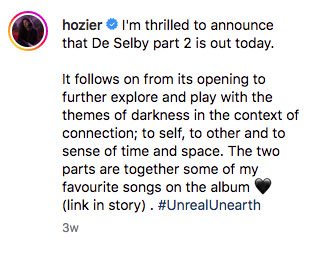
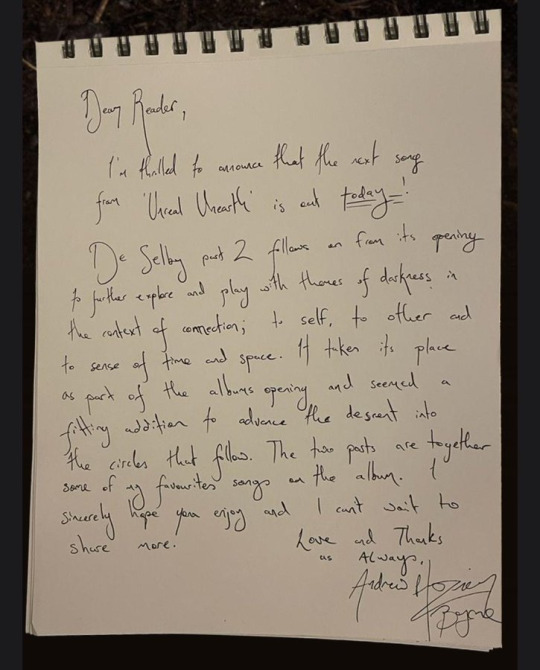
What you're given, what you live in Darlin', it finds a way to live in you
"The gross and net result of it is that people who spent most of their natural lives riding iron bicycles over the rocky roadsteads of this parish get their personalities mixed up with the personalities of their bicycle as a result of the interchanging of the atoms of each of them and you would be surprised at the number of people in these parts who are nearly half people and half bicycles"
First Time
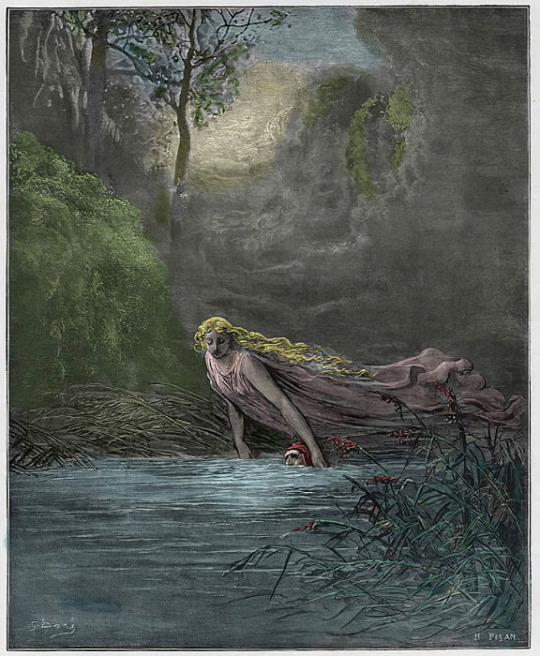
Remember once I told you about How before I heard it from your mouth My name would always hit my ears as such an awful sound
First Time refers to Beatrice Smiles: Canto XXXI - Dante's meeting with Beatrice after being left by Virgil, where she rebukes him for his sins. Dante does not remember his name but recognises Beatrice. He was dunked into the River of Forgetting by Matelda
“Respond, you of poor memory, confess. _Lethe awaits. Your thoughts are undeterred.”
These days I think I owe my life To flowers that were left here by my mother Ain't that like them, giftin' life to you again
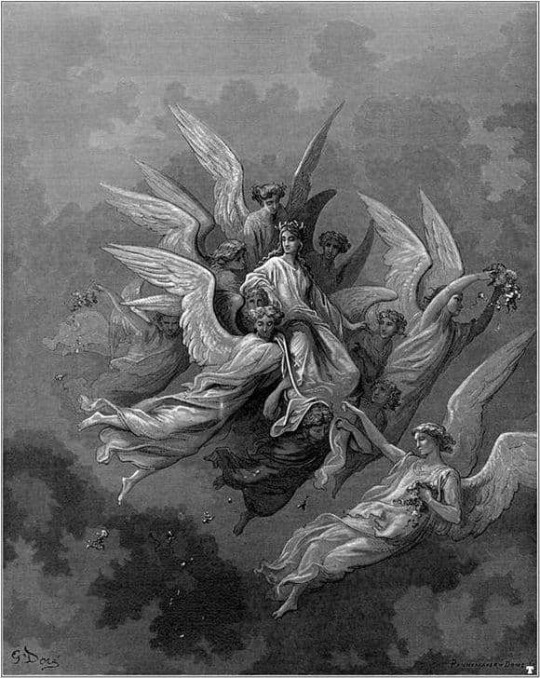
Francesca
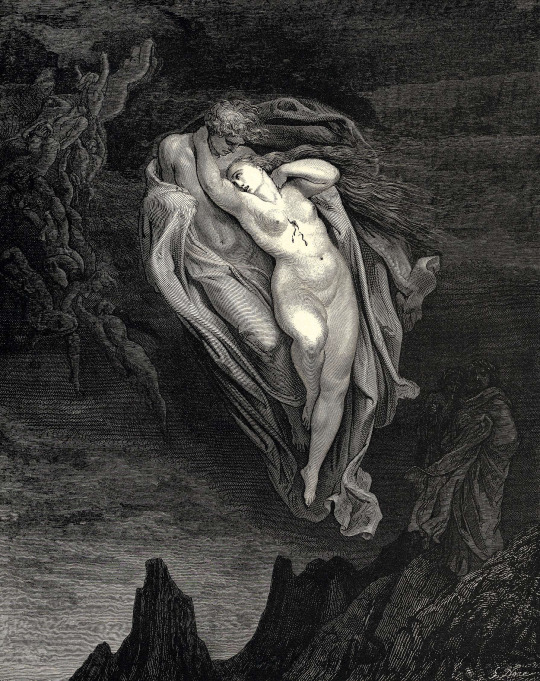
In Dante's Inferno, the character of Beatrice embodies love inspired by God - she is a religious object that should inspire faith, devotion, and salvation. By contrast, the character of Francesca da Rimini is encountered in the Terrace of Lust. She was a medieval noblewoman who was killed by her husband, Giovanni Malatesta upon discovering an affair between her and Paolo Malatesta (his brother). She represents love that leads one's soul to destruction.
I would not change it each time Heaven is not fit to house a love like you and I I would not change it each time
"Love led us to one death, conjointly felled. __For him who slew us, Cäina waits below."
I Carrion (Icarian)
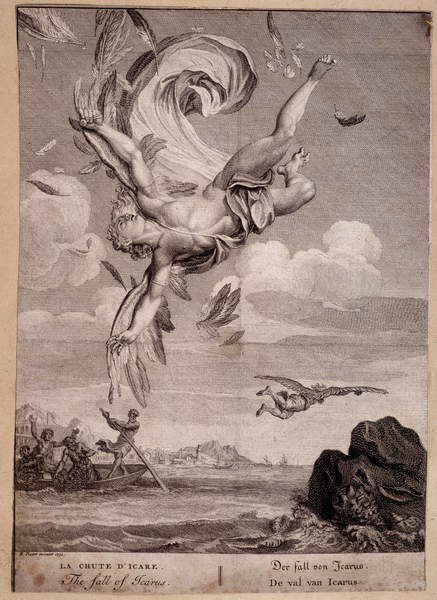
One deep breath out from the sky I've reached a rarer height now that I can confirm All our weight is just a burden offered to us by the world
This song has a connection with Inferno 17. Phaeton, Icarus, Daedalus and Arachne: are symbolic of Ulysses, the embodiment of transgression in Dante’s personal mythography. Icarus is a figure of fear for because he was equipped by his father to alter the boundaries of man's physical nature. It is the sin of pride that leads one to folly.
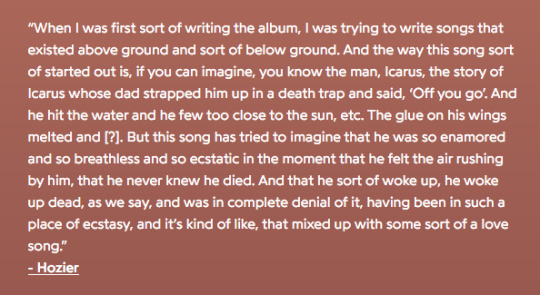
Eat Your Young
“Eat Your Young”, a contemporary riff on the Irish writer Jonathan Swift’s 1729 satirical essay “A Modest Proposal” that suggests Irish people eat their children to alleviate their hunger and poverty.
Come and get some Skinnin' the children for a war drum Puttin' food on the table sellin' bombs and guns It's quicker and easier to eat your young
The first verse also contains allusions to Canto 6 of Inferno - this level is related to "gluttony" but it's used by Dante to discuss the political landscape and moral failures of the City of Florence. Gluttony, in this case, is defined as excessive desire for dominion and power. So Hozier comments on inequality and poverty with a distinctly political air.

Damage Gets Done
Here Hozier refers to Canto 7 of Inferno and the concept of misura - a lack of moderation or self-control
And darlin', I haven't felt it since then I don't know how the feelin' ended But I know being reckless and young Is not how the damage gets done
In this Canto, Dante is discussing wealth management - hoarding and wasteful spending. While avarice is a traditionally Christian sin, Dante inserts the sin of prodigality by himself. This tells us that Dante's moral standard is not essentially Christian. Hozier also plays with the intentions of the texts he refers to and inserts his own takes on philosophy and biography. Very Dantean, if you ask me.
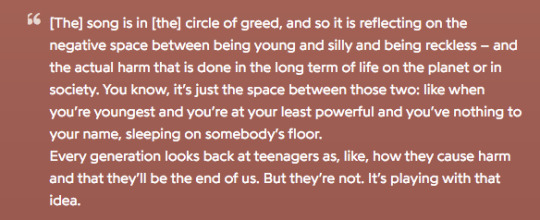
Who We Are
I think this is a narrative shift similar to Canto 8-9 where the fallibility of Virgil is explored and the tension between faith and fear.
You only feel it when it's lost Gettin' through still has a cost Quietly, it slips through your fingers, love Falling from you drop by drop What I had left here I just held it tight So someone with your eyes might come in time To hold me like water Or Christ, hold me like a knife

Son of Nyx
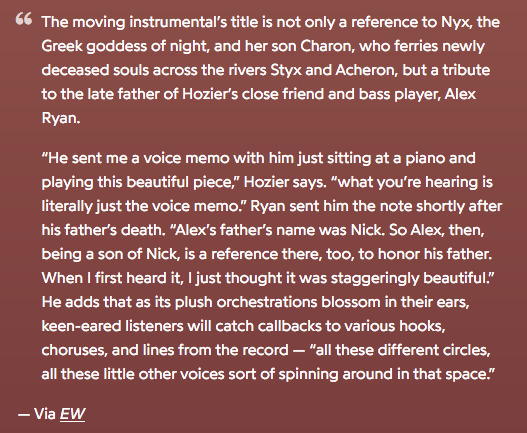
All Things End
The mystery at the heart of Inferno 10, the mystery that generates its enormous poetic power, is the connection of love to sin.
All Things End is superficially about the end of a relationship but it's also about heresy. The specific heresy in the canto is Epicureanism: materialism that suggests the soul dies with the body. It is a denial of the idea of an immortal soul and a "wilful separation of the soul from God". The Epicureans in Canto 10 are represented as eternally trapped in the temporary and ephemeral materialistic reality of the present. They are denied what is eternal and transcendent (ie divine)
And all things end All that we intend is scrawled in sand And slips right through our hands And just knowing That everything will end Should not change our plans When wе begin again
To Someone From A Warm Climate (Uiscefhuarithe)
‘Uiscefhuarithe’, as described by Hozier, is an irish word for ‘something that has been made cold by water’.

Butchered Tongue
The Genius annotation gives a lot of detail here: In “Butchered Tongue”, Hozier tackles the 7th Circle of Hell Canto XII to XVII, known as the ‘Circle of Violence or Hell of the Violent and Bestial’ which is one of the lower circles of Hell and is divided into three distinct rings, each punishing different types of violence. The track focuses mainly on the first ring called the ‘Outer Ring’ where those who commit violence against others and their property are punished by being submerged in a river of boiling blood called the Phlegethôn, and centaurs patrol the area, shooting arrows at those who emerge from the blood.

The song has a number of allusions to the horrors of colonial violence.
Anything But
I think this song refers to Canto 26 which establishes the critical metaphor that equates desire with flying. Here Dante encounters Ulysses - the embodiment of the epic wandering hero.
"But here one must fly, I mean with the swift wings and the pinions of great desire."
Canto 26 is critical of imperial ambitions and expansionism as Dante casts the city of Florence as a giant bird of prey whose wings beat over land and sea. This is thought as representing a specter of tyranny.
Dante presents Ulysses as the ultimate flawed hero that embodies the expression of desire as flight. Hozier expresses his desire for flight and wandering in Anything But.
I wanna be the shadow when my bright future's behind me I wanna be the last thing anybody ever sees I hear he touches your hand, and then you fly away together If I had his job, you would live forever
Abstract (Psychopomp)
Here Hozier references a childhood trauma of witnessing an animal being hit by a car and Canto 28. It's somewhat alike to the canto in a metatextual sense because it presents a gruesome picture. In Inferno 28 souls are mutilated by devils. The language is pretty clinical and graphic, like the song.
"Who, even with untrammeled words and many attempts at telling, ever could recount in full the blood and wounds that I now saw?."
The poor thing in the road, its eye still glistening The cold wet of your nose, the earth from a distance
Unknown / Nth
This one has a lot of references that have been discussed by Hozier for its allusions to the ninth circle of Hell and Cantos 34. The ninth circle is sometimes referred to as treachery but the sin is fraud.
betrayal is fraud committed against those who trust us
Hozier said he conceived of Satan/the Devil as the first prisoner of hell. I've got to link the Digital Dante article about this Canto because it's very relevant:
You know the distance never made a difference to me I swam a lake of fire, I'd have walked across the floor of any sea Ignored the vastness between all that can be seen And all that we believe So I thought you were like an angel to me
First Light
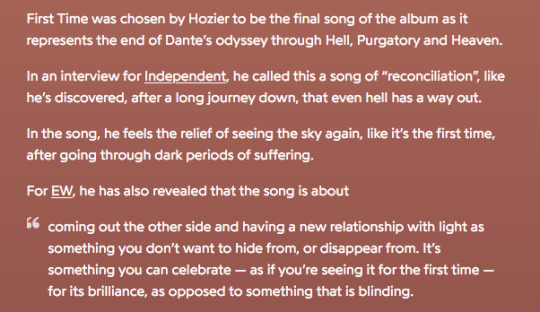
One bright morning changes all things Soft and easy as your breathing, you wake Your eyes open at first a thousand miles away But turning shoot a silver bullet point-blank range And I can scarce believe what I'm believing in Could this be how every day begins?
"Whichever day it was, it was a gentle day – mild, magical and innocent with great sailings of white cloud serene and impregnable in the high sky, moving along like kingly swans on quiet water. The sun was in the neighbourhood also, distributing his enchantment unobtrusively, colouring the sides of things that were unalive and livening the hearts of living things" - The Third Policeman
Visual imagery
"Down into the earth where dead men go I would go soon and maybe come out of it again in some healthy way, free and innocent of all human perplexity." - The Third Policeman

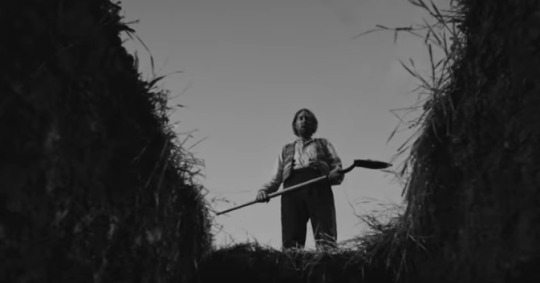
"Not everyone know how I killed old Phillip Mathers, smashing his jaw in with my spade." - The Third Policeman - Flann O'Brien
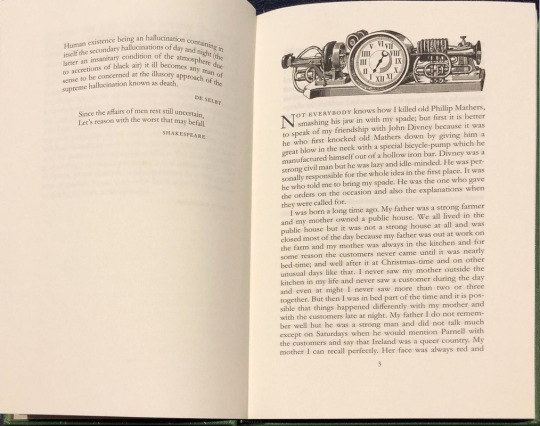
“If a man stands before a mirror and sees in it his reflection, what he sees is not a true reproduction of himself but a picture of himself when he was a younger man”
Reading list
“Eat Your Young”, a contemporary riff on the Irish writer Jonathan Swift’s 1729 essay “A Modest Proposal”
The Third Policeman by Flann O’Brien: an expert investigation
Bestselling author Michael Foley celebrates a comic, Kafkaesque masterpiece and explores what makes it great. But why was it cannibalised
The Irish Times
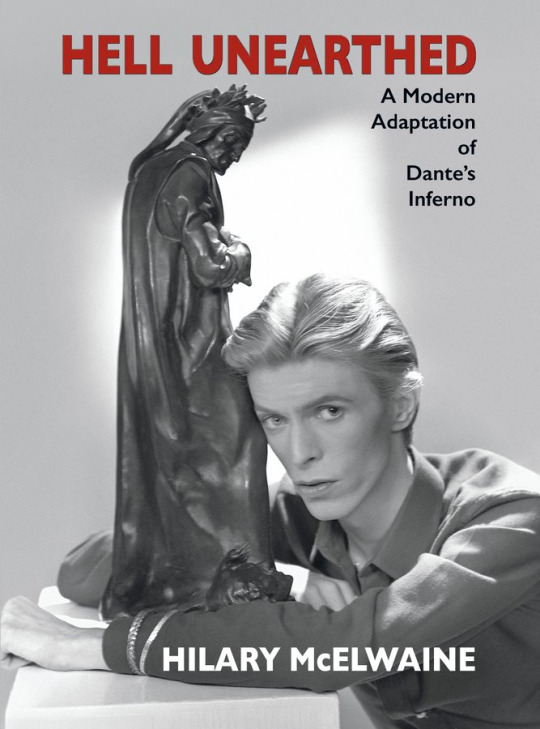
The Icarian Community Nauvoo | Paul M. Angle
Re-admitted to France, Cabet made plans to move his ideal society from the printed page to reality. In December 1847, he announced that Ic
fee.org|Paul M. Angle
An overview of the 1798 Irish rebellion
Interviews
“We betray ourselves in the act of opening up to somebody and believing so much,” Hozier says, passing a hand across his face. He looks weary, all of a sudden, voice cracking a little. “Our eyes betray us, our hearts betray us, our minds betray us. And that’s the ‘Nth’ reference: we open ourselves up to something, only to betray ourselves…”
Hell, at Least According to Hozier, Never Sounded Sweeter
On the eve of his return to the spotlight, the Irish crooner mulls over Ovid, 'Inferno,' and his status as the internet’s forest king.
Vanity Fair|Condé Nast
Hozier: ‘I think everyone goes through their version of hell’
The Irish artist is releasing his long-awaited third record ‘Unreal Unearth’, which was inspired by Dante’s Inferno. He speaks to Roisin O’C
The Independent
“There’s a subtle element and I wanted to be light and playful with it. The album can be taken as a collection of songs, but also as a little bit of a journey. It starts with a descent and I’ve arranged the songs according to their themes into nine circles, just playfully reflecting Dante’s nine circles and then an ascent at the end”
the album reflects upon two of the nine circles of hell: gluttony and heresy.
“There’s some moments that are a bit more old school and stuff that’s Nineties grunge sounding too. For other moments we were leaning into playing with a lot of synthesisers. But we’ve arranged the album into circles and the EP just represents two of those – those soul moments within it.” - Rolling Stone Interview
Divine Comedy explainers
Dante's 9 Circles of Hell: A Guide to the Structure of 'Inferno'
Here's a structural overview for the nine circles of hell in Book 1 (Inferno) of Dante Alighier's Divine Comedy.
ThoughtCo
Full Glossary for The Divine Comedy: Inferno
Absalom Bible. David's favorite son; killed after rebelling against his father: 2 Samuel 18.Acheron the River of Sorrow.Achilles Greek Mytho
cliffsnotes.com
Dante Alighieri: Mythology in the Divine Comedy
Mythology in the Divine Comedy Throughout Dante’s work “The Divine Comedy”, the author uses Greek and Roman mythology to elevate and to pro
ITAL3550SLU - Medieval & Renaissance Italian Literature
Reviews
Hozier - 'Unreal Unearth' review: Epic, expansive and ethereal
On his third album, the Irish sing-songwriter utilizes simplicity and space while venturing into new sonic territory — Read the NME review
NME|Aliya Chaudhry
Hozier: Unreal Unearth album review — solitude, spirituality and a touch of Dante | Financial Times
The singer’s roar is as impressive as ever but he also deploys other vocal styles to fine effect in his third album
ft.com
On Unreal Unearth, Hozier Makes His Boldest Work Yet
On Unreal Unearth, Hozier works through biblical source material and Dante's Inferno to make sense of isolation and human sorrow.
Paste Magazine
Hozier – ‘Unreal Unearth’ album review: A beautiful, angst-filled journey through the nine circles of hell
'Unreal Unearth' dives into the concept of Dante's Inferno.
Far Out Magazine
Unreal Unearth review | Hozier merges pop with profound prose
From the haunting echoes of Irish folklore to the pulsating beats of indie pop, this is Hozier at his artistic peak. Read our Unreal Unearth
whynow
Album: Hozier - Unreal, Unearth
Only a few artists can be said to have exploded on to the scene like Hozier. The solo, Irish musician – full name Andrew John Hozier-Byrne –
theartsdesk.com
120 notes
·
View notes
Text


Eyescream Feb 2015
PATCHWORK
Patchwork is made by hand, joining together small pieces one by one. The skill of joining different colors, patterns and even materials into a single piece of fabric cannot be mastered in one move. This is why the sense and taste of the designer or craftsman are clearly expressed.
Patchwork is a representative low-tech fashion art piece.
Patchwork is a craft in which pieces of cloth are sewn together to make a single piece of fabric. It first emerged in India and China, the countries where the fabric is produced, as a way to recycle old fabric, before spreading to Europe. Among the wealthy, displaying original pieces they had made themselves in their homes and showing them to their guests became a status symbol. This proves that it is a method of expression that requires ingenuity and creativity. From fashion houses to independent brands, priority is given to unique, one-of-a-kind pieces based on originality.
(Top row, from right) Worker vest ¥13,800 (TIGRE BROCANTE),
T-shirt ¥12,000 (TALKING ABOUT THE ABSTRACTION),
Shirt ¥34,000 (COMME des GARÇONS HOMME),
jacket ¥300,000 (ANREALAGE),
zip hood parka ¥69,000 (White Mountaineering),
(Middle row, from right) Shirt ¥42,000 (visvim),
scarf ¥450,000 (Rare Weaves) UNITED ARROWS,
hoodie ¥31,000 (Leny Lay Lack),
sandals ¥16,000 (mythography),
denim pants ¥59,000 (TAKAHIROMIYASHITATheSoloist.),
long T-shirt ¥22,000 (GANRYU) COMME DES GARCONS
(bottom row from right) tote bag ¥20,000 (YAVO LAB),
sneakers ¥38,000 (White Flags),
pants ¥38,000 (whowhat),
pullover cut and sew ¥43,000 (COSMIC WONDER), scarf ¥14,000 (Old park),
shirt ¥21,000 (ROUGH & TUMBLE),
jacket ¥45,000 (RED EAR)
#my scans#fashion#avantgarde#japanese fashion#2010s fashion#takahiro miyashita#takahiromiyashita the soloist#visvim#comme des garçons#comme des garcons homme plus#patchwork
9 notes
·
View notes
Text
We have not yet done very large things with the true mythography of Donald Duck, but the spirit beckons us on
8 notes
·
View notes
Note
Ok I have just been scrolling on your blog for like ages now and I just wanna say that I find your greek mythology rants literally so interesting bc a) they are so informative and when reading them it's obvious your dedicated abt it and b) I just love the way you write??? There's so much passion and it makes reading all your posts so interesting. I just love the info dumps especially bc I really want to know more abt greek mythology but I just don't have the time + have no idea where to start finding this information.
Plus I just really really love your art. It's so adorable?? I love your style and the way you draw your characters I just want to bundle them all up and never let go like I am literally etching every last bit into my brain.
Anyways I hope this doesn't seem like weird ☀️
These are like the kindest compliments, thank you!!!!
I'm so glad my passion for mythology comes through in my writing bc I do care so much about greek mythology and like mythology in general, if I thought I could make it in academia I would totally get a job in mythology research it is one of my favorite things. AND! I have a couple of resources I would totally recommend for a good place to start researching!
Theoi.com: oml this is such a phenomenally good resource for greek mythology. It has a whole bunch of different information and all of it is linked back to it's original source from antiquity. I will say that the writing on the website can be a bit dense, but it's not horrible and I could not recommend this site enough as a source for information.
If you have the money to buy a book I would recommend getting a copy of the Apollodorus' Library. This is a collection of mythography (It's like a mythological dictionary) that is thought to have been written around 2nd century BC. So, two plusses. 1. It's a primary source. 2. It has a lot of myths in a small package. Obviously, the original book is in ancient greek, which I sadly have not learned to read, but there are a lot of really good translations in english that are readily available. The one I have was translated by R. Scott Smith and Stephan M. Trzaskoma, and it's really cool because it also has the translated Hyginus' Fabulae, which is also mythography but this time it's roman. So like, two in one go! Woop woop!
After these two resources, I would recommend going trying to find resources that go more in depth on whatever myth catches your eye. Of course, that could be anything, so I can't really offer up a certain book or website for that, but I can give a couple of tips I use when looking into potential sources of information!
Primary resources!!! Always look for primary resources!! These are the sources that are actually from ancient greece, and have little to no additions from an author. I know these sources are usually more dense and harder to get through, but I think it's good to have an understanding of the original myth before you start looking at other people's interpretations of that myth, just so you don't get their thoughts confused with the actual original text. If you're having trouble figuring out if a book or site is a good primary research, search it up and look for reviews! Usually there's at least a couple people talking about how good the source is academic-wise.
I would always encourage researching ancient greek and roman history alongside researching mythology. These myths did not exist in a vacuum, and a lot of the time certain myths and stories are the direct result of the culture and politics of the era. I think the connections between greek mythology and history give you a greater understanding of both topics, and is always a good step!
(Also just my bias showing, but greek art history!!! is so good!!! and tells you so much about the culture!!! and then roman art history is also great!!! Because you get to see how the artists of rome used the cultural and artistic values of greece to create meaning and influence the people!! Like, Octavian purposefully had himself sculpted in a hellenistic style so that people would be less worried about him ruling from such a young age?? That's so interesting!!! I love art history!!!!)
I will say a lot of this does take a lot of time (I only really have time to research now bc it's summer so i'm not in college ;-;) but I really think it's such an interesting field, as you can probably tell by how long this was.
60 notes
·
View notes
Note
Random asks for your boredom!
What do you consider the first thing you ever wrote?
When writing, what do you consider "finished"?
What's a weird childhood memory you have?
Any pets you wanna tell us about?
If you cook at all, even in the microwave, what is your favorite recipe?
Earliest writing project that I remember was a book series deeply influenced by Percy Jackson called Mythography. It involved various mythological gods fighting a shadowy government organization.
Whenever it has helped me personally grow (not necessarily growing as an artist)
I genuinely believed that a ladybug changed the lockscreen on my father's desk top
No pets, but I just got my first car! So that is the being in my life that I love
I'm a big fan of pan-frying salmon fillet in olive oil for four minutes on the side with skin, three minutes on the other side, and dropping three spoonfuls of mayonnaise into the pan 30 seconds before I turn off the stovetop. I like to season with salt and Tabasco
3 notes
·
View notes
Note
what makes bres such a special boy to you
I mean, you know better than almost anyone how long he's been following me, how long I've been following him. I've been to this man's grave site, like. Within the next year, I intend to have visited this man's fortress, or what's left of it. I've crossed oceans for him, multiple times. I've argued for him, consistently, advocated for him, and, if nothing else, I can say that, if people think I'm obsessed or one-note, they HAVE had to think about him. He has changed my life and he's continued to change my life, and the way I understand him now isn't the way I first understood him when I was 14, which won't be how I understand him when I'm 40. In some ways, you could say that he and I have grown up together.
And...there's a lot to draw me to him. As a character, he's fascinating, because from the evidence we have, the villainous depiction of him in Cath Maige Tuired, his main text, is a recent development -- it SEEMS most likely that he was a prominent literary figure who was viewed positively, but because the author of CMT wanted to make a political point, he was made into an anti-king character, a villain to represent the ultimate degradation of the social order. Even there, he's isn't what you'd expect from a tyrant figure -- he isn't BLOODTHIRSTY. An entitled brat, yes, but not bloodthirsty. Not sexually predatory.
When I first started working with him, I pictured him as this kind of seductive, bad boy character. His goal was to act as this figure of temptation for a (now cut) OC of mine. But the problem was that, the more I looked into him, the more it didn't work. But I kept working with him, kept fiddling with him, looking into more texts, and I think that it finally set in for me when I was 16, and I had just cut off contact with my father. And I was...I wasn't a wreck -- after the initial crying fit was over, I was more angry than anything else, as I recall, but I was a little lost. Like, here was this image of a family that I'd had in my head, this image of a relationship with my father that I'd never have, and it was gone.
And I was rereading Cath Maige Tuired, and I distinctly remember reading Bres seeing his own father for the first time, after his father essentially asks him why the fuck he's bothering to go to him in Lochlann, doesn't he have a kingdom of his own, and thinking about Bres' response: "I have a question then: what advice do you have for me?"
And I remember reading it, for the first time, not as something snarky, not as him being stupid, but him being lost. This young man, possibly no more than 25, visiting his father for the first time, probably having all these preconceptions about this man, and his response to him is "Why are you here? What are you doing here? Why are you invading my life?" Scholarship is overwhelmingly sympathetic to Elatha in this scene; it thinks that Bres is the unworthy son of a great father. I read it and I see a creation looking at its creator and going "do you have anything useful to give me? You created me, why?" Bres is a Frankenstein story, he's created by Elatha, had this name put on him by Elatha, and then summarily abandoned to his fate.
And as I got older, as I developed myself a little bit more, as I learned that Celtic Studies was a FIELD, I remember reading John Carey's Myth and Mythography in Cath Maige Tuired, where he made the argument that Bres was originally a positive figure but also pointed out that Bres fulfills an ungodly number of traits associated with the Irish HERO. It was also...interesting to me, the more work I did, how often that women come up in Bres' life, how the women of the tribe support him in the kingship, how his mother is his closest relationship in the text, and that hit me VERY hard in the "raised by a single parent." (I've also done a lot of thinking about how he's queered by that connection to the women, how it's a way of showing that he doesn't live up to the standards of masculinity in medieval Ireland, because Bres was ALWAYS for the girls and the gays.) That was what spurred me onto my undergrad, where I did a lot of work on Bres' fall from literary grace, where I also developed the idea for my MA thesis. I think it's easy, when looking at this grand, heroic texts to focus on the hero -- because we want to BE like the hero, don't we? The hero exemplifies society, exemplifies those neat little categories. We want to be effortlessly skilled, or charismatic, or beautiful, but what happens when, for whatever reason, you fail? What happens when you're Salieri and not Mozart? And CMT is a text that is BIG on parallels -- there are so many ways that Lugh, Bres, and Nuada parallel and contrast one another, they're built up deliberately as foils to one another. So, I understand why Lugh is more popular, but I'm more interested in Bres because I think he's the more realistic, the more human of the two of them. He's a man who isn't a monster, who isn't portrayed in the text as a monster, but he isn't enough, even when he tries, and possibly never could be, and who ends up becoming the Tuatha Dé's own rabid dog, turning against his masters. It's great to like Lugh, to admire Lugh (even though he IS murderous in other texts), but how many of us are more like Bres than Lugh, at the end of the day?
I also dealt more, during my undergrad, with OTHER texts where he shows up, often more positively. His relationship with Sreng in the First Battle was really interesting to me, seeing Bres develop this positive relationship with someone else from another tribe, seeing him genuinely experience friendship, even if it's for a little while, even if it's bittersweet because they have to fight one another. There's the reference in his death tale to him dying "without successful progeny" -- he outlived his children, and we see his son die in CMT "in his father's presence" -- Bres literally watched his son die in front of him due to an order *either he or the rest of the Fomorian leadership gave* and he is STILL dehumanized in depictions of him, with some adaptations even having him coldly have Ruadán die at his feet.
And then, as I was rereading CMT in the Old Irish a couple of years ago, I made the realization that he is actually described as a "mac" -- a boy. He's this symbol of corruption and failure but he's also neurodivergent and a minor a *child* -- whose fault is it more? The child for ruling poorly, or the adults who put him in that situation in the first place? By the time he takes revenge, sure, he's an adult, he's responsible for everything he does, but he starts this out as a potentially seven year old boy king, where no one wanted him in that position because he was replacing a very popular king suddenly.
So. He haunts me. I think he always will. I don't see a time when I'll ever stop being haunted by him. Like, I've entwined my life around his and...I'm kind of okay with that. I do a lot more than just him, but I also think that he's the first association people usually have with me, and...that's okay. That's a kind of immortality too, isn't it? To tie yourself that tightly to something that's lasted for a thousand years? I'm very happy to chase him for another few decades, though who knows if I'll ever fully understand him, because I think, in order to do that, I'd have to understand myself, every single part of my soul, as well as fully understanding the souls of the various scribes in medieval Ireland who wrote down these stories, and that's an impossible task.
In other words, "this thing of darkness, I acknowledge mine."
7 notes
·
View notes
Text
In Roman mythology, Dea Tacita ("the silent goddess") also known as Dea Muta or Muta Tacita, was a goddess of the dead.[1][2][3] Ovid's Fasti includes a passage describing a rite propitiating Dea Tacita in order to "seal up hostile mouths / and unfriendly tongue" at Feralia on 21 February.[4][5] Dea Tacita is the same as the naiad Larunda.[6][7] According to Ovid this occurred because Dea Tacita had her tongue ripped off by Jupiter. Jupiter was angry with her because she told the nymph Juturna to flee from him because he planned to rape her.[8] In this guise, Dea Tacita was worshipped at a festival called Larentalia on 23 December.[9] Goddesses Mutae Tacitae were invoked to destroy a hated person: in an inscription from Cambodunum in Raetia, someone asks "ut mutus sit Quartus" and "erret fugiens ut mus"[10] ("that Quartus be mute" and that he "wander, fleeing, like a mouse").[11]Plutarch, who described Tacita as a Muse, states that Numa Pompilius credited Tacita for his oracular insight and taught the Romans to worship her.[12]
Larunda (also Larunde, Laranda, Lara) was a naiad nymph, daughter of the river Almo and mother of the Lares Compitalici, guardians of the crossroads and the city of Rome. In Ovid's Fasti she is named Lara.[1]
Myth
See also: Mother of the Lares
The only known mythography attached to Larunda is little, late and poetic, in Ovid's Fasti. Ovid names her Lara, an excessively loquacious river-nymph, daughter of the river-god Almo. Ignoring parental advice to curb her tongue, she betrays Jupiter's secret, adulterous affair with the nymph Juturna, wife of Janus, to his own wife, Juno. Jupiter wrenches out Lara's tongue and orders Mercury, psychopomp and god of boundaries and transitions, to conduct her to the "infernal marshes" of Avernus, the gateway to the Underworld, the dismal realm of Pluto. Along the way, Mercury rapes her, despite her pleading glances. Mute (Latin muta) and silent (Latin tacita), she thus conceives the divine Lares, twin guardians of crossroads and the city of Rome.[1]
Larunda's original name, according to Ovid, was "Lala", imitative of her garulous speech. Robbed of the power of speech, she is likely identical with Muta "the mute one" and Tacita "the silent one": nymphs, minor goddesses or aspects of a single deity with semantic connections to the Lares and perhaps the Lemures as darker forms of Lares.[2][3]
Cult
Ovid expounds this myth of Lara and Mercury in the context the festival of Feralia on February 21,[1] and an informal, secretive women's folk-cult at the same festival, invoking Tacita ("the silent goddess"). The rite is led by "an old hag" who holds seven black beans in her mouth; it has similarities to the exorcism of hostile, vagrant spirits at the Lemuria festival, but is completed when a fish-head is sewn up to "bind hostile tongues to silence". Lara/Larunda is also sometimes associated with Acca Larentia whose feast day was the Larentalia on December 23.[4]
The Mother of the Lares (Latin Mater Larum) has been identified with any of several minor Roman deities. She appears twice in the records of the Arval Brethren as Mater Larum, elsewhere as Mania and Larunda. Ovid calls her Lara, Muta (the speechless one) and Tacita (the silent one).
Lares (/ˈlɛəriːz, ˈleɪriːz/ LAIR-eez, LAY-reez,[1] Latin: [ˈlareːs]; archaic lasēs, singular lar) were guardian deities in ancient Roman religion. Their origin is uncertain; they may have been hero-ancestors, guardians of the hearth, fields, boundaries, or fruitfulness, or an amalgam of these.
Lares were believed to observe, protect, and influence all that happened within the boundaries of their location or function. The statues of domestic Lares were placed at the table during family meals; their presence, cult, and blessing seem to have been required at all important family events.
Roman writers sometimes identify or conflate them with ancestor-deities, domestic Penates, and the hearth.
Because of these associations, Lares are sometimes categorised as household gods, but some had much broader domains. Roadways, seaways, agriculture, livestock, towns, cities, the state, and its military were all under the protection of their particular Lar or Lares. Those who protected local neighbourhoods (vici) were housed in the crossroad shrines (Compitalia), which served as a focus for the religious, social, and political lives of their local, overwhelmingly plebeian communities. Their cult officials included freedmen and slaves, otherwise excluded by status or property qualifications from most administrative and religious offices.
Compared to Rome's major deities, Lares had limited scope and potency, but archaeological and literary evidence attests to their central role in Roman identity and religious life. By analogy, a homeward-bound Roman could be described as returning ad Larem (to the Lar). Despite official bans on non-Christian cults from the late fourth century AD onwards, unofficial cults to Lares persisted until at least the early fifth century AD.
2 notes
·
View notes
Text
I think the fact that retellings of Greek Mythology are getting more popular is amazing, and I hope it inspires more adaptions of less well-known myths, because, frankly, I'm getting sick of the same three or four myths being used as representations of all Greek mythography
In the meantime, if you're looking for a good musical adaptation of the Iliad, allow me to direct you to the frankly underappreciated play - Aristos : The Musical
If you liked TSOA, you'll love it
Check it out on Youtube here
And on Tumblr here : https://www.tumblr.com/aristosmusical
#the song of achilles#tsoa#aristos#aristos achaion#aristos the musical#achilles#achilles x patroclus#patroclus#patrochilles#greek mythology#tagamemnon#classical mythology
27 notes
·
View notes
Text
Faeries as Fallen Angels?
This article presents an intriguing look into the diverse and complex theories about the origins of fairies in folklore and mythography. It highlights how the interpretation of these creatures has evolved, particularly with the influence of Christianity on pagan beliefs.
The concept of fairies as fallen angels is a fascinating example of how Christian theology was integrated into existing pagan and traditional beliefs about supernatural entities. This particular explanation posits that fairies are neither wholly evil nor completely benign, existing in a liminal space between heaven and hell, which adds a rich layer of complexity to their folklore. According to this belief, these creatures were angels who fell from heaven during Lucifer's rebellion but were not condemned to hell, instead inhabiting the earth. This narrative not only explains their supernatural abilities, such as flying or dwelling in subterranean realms, but also imbues them with a tragic quality—caught in an eternal limbo, with some still longing for heaven.
Moreover, the narrative ties into broader cultural interpretations seen in various regions such as Scotland, Wales, and Ireland, where fairies are often connected with ancient mythologies like the Tuatha de Danann. These connections exemplify how deeply ingrained these beings are in the cultural and spiritual life of these regions, reflecting a blend of mythology, folk belief, and religious interpretation.
The story of the fairy woman and her inability to recite the "Our Father" prayer is particularly poignant. It symbolizes the fairies' estrangement from the divine and their affiliation with the fallen angel, Lucifer, underscoring the complexity of their nature in folklore—neither wholly evil nor capable of redemption.
The inclusion of Thomas the Rhymer’s story further emphasizes how fairies were woven into the moral and spiritual fabric of medieval folklore, serving as metaphors for choices between good and evil, and paths to salvation or damnation.
While the notion of fairies as fallen angels wasn’t the most prevalent in medieval times, it certainly provides a rich tapestry for understanding how these mythical beings were perceived and how their stories reflected the theological and moral concerns of the times. The blending of Christian and pagan elements in these tales is a testament to the dynamic nature of folklore, continually evolving to incorporate new beliefs while reflecting the values and fears of those telling them.
4 notes
·
View notes
Text
"Another chapter appears, as set out in the manuscript [Anonymus Florentinus], to list the impious. … After this come five cases of variously wicked people (three of them rapists) who shared the same fate, being struck by a thunderbolt: … Alphaeus, the son of the River Sangarius, taught Athena to play the flute and after trying to rape the goddess was struck by a thunderbolt from Zeus. Ardys the son of Hippocoon tried to rape Hera when she was traveling to Argos and was struck by a thunderbolt from Zeus. Phorbas the Thesprotian fell in love with Demeter and, when he tried to rape the goddess, was struck by a thunderbolt from Zeus." (Alan Cameron, Greek Mythography in the Roman World)
"For although he [Ixion] received a sweet life among the gracious children of Cronus, he did not abide his prosperity for long, when in his madness of spirit he desired Hera, who was allotted to the joyful bed of Zeus. But his arrogance drove him to extreme delusion; and soon the man suffered a suitable exquisite punishment. Both of his crimes brought him toil in the end. First, he was the hero who, not without guile, was the first to stain mortal men with kindred blood; second, in the vast recesses of that bridal chamber he once made an attempt on the wife of Zeus. … Ixion brought upon himself the four-spoked fetter, his own ruin." (Pindar, Pythian 2)
"Hera, while she was being nurtured by her parents, was raped by one of the Gigantes, Eurymedon, and she became pregnant and bore Prometheus. Zeus, after marrying his sister and learning of the event, punished Eurymedon by throwing him into Tartarus, and Prometheus, under the pretext of fire, was bound in chains. The story is in Euphorion." (Scholion to Iliad 14.295)
"Electra, daughter of Atlas, had two sons, Iasion and Dardanus, by Zeus. Now Iasion loved Demeter, and in an attempt to defile the goddess he was killed by a thunderbolt." (Pseudo-Apollodoros, Library 3.12
"Because Latona had lain with Jove, Juno ordered Tityus, a creature of immense size, to offer violence to her. When he tried to do this he was slain by the thunderbolt of Jove." (Pseudo-Hyginus, Fabulae 55)
"But Idas came to Messene, and Apollo, falling in with him, would have robbed him of the damsel. As they fought for the girl's hand, Zeus parted them and allowed the maiden herself to choose which of the two she would marry; and she, because she feared that Apollo might desert her in her old age, chose Idas for her husband." (Pseudo-Apollodoros, Library 1.7.9)
"… but Daphne, seeing Apollo advancing upon her, took vigorously to flight; then, as he pursued her, she implored Zeus that she might be translated away from mortal sight, and she is supposed to have become the bay tree which is called daphne after her." (Parthenios, Love Romances 15)
What a protector of women and respecter of women's autonomy, amirite? I mean, if killing one (1) rapist and supporting one's gender nonconforming daughters makes a male god a feminist and the protector of women then surely Zeus qualifies as well.
11 notes
·
View notes
Text
Eyescream Feb 2015
My personal back order
Hidetaka Miyagi (mythography)
STETSON cowboy hats and Navajo jewelry

4X Beaver Hats by STETSON. Numerous Navajo jewelry pieces that I have collected so far.

Shoe brand (mythography) designer Hidetsugu Miyakoshi has something he's been holding onto for a long time: back-ordered pieces of Hat and Nava jewelry.

Hidetaka Miyagi
mythography / but no more and less... Designer. While working as a salesperson for a shoe brand, he started to teach himself design, and launched his own brand [mythography] in 2012. Taking inspiration from elements such as vintage clothes and homelessness, he creates shoes using his senses without relying on knowledge. In 2015 S/S, he will also start a shoe brand called [but no more and less...].
The back-ordered items that Miyagi introduced us to this time were a cowboy hat and Navajo jewelry from STETSON. The hat is made of beaver felt, known as "4x Beaver," which makes it highly durable. The inside is lined with nylon, which real cowboys use to scoop up water. "I remove the ribbon and iron the brim to make it flat. If you wear it out in the rain, it will develop a unique texture. The felt on vintage hats is in better condition than current hats."
Navajo jewelry is jewelry made by the Navajo people who live in Arizona and New Mexico in the United States. It is said that the Navajo were the first to create Indian jewelry, and the jewelry they make is characterized by the use of silver and turquoise. "The first time I saw it was a squash blossom at Nepenthes, and it was a big shock. I thought, "There's something like that? I didn't want to buy it at the time, but as I got older, I wanted it more and more (laughs). I have a store called "The Fillmore" that is run by an acquaintance of mine, and I get my Navajo jewelry from there, including this hat. That's because I choose which pieces to purchase at the purchasing stage by looking at the materials sent to me by local buyers. But it's not so easy to find the design you want. It takes a long time to find something you want after telling them you want it. But the time you spend waiting makes it even more satisfying when you get it."
7 notes
·
View notes